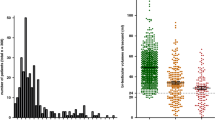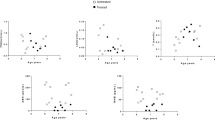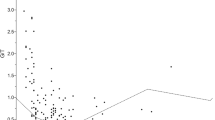Abstract
Impaired intrauterine gonadotropin secretion was the cause of cryptorchidism in 78% of cryptorchid boys studied. On the one hand, this impairement implied the underdevelopment of the epididymis and thus the cryptorchid state of the gonad. On the other hand, the histological alterations of the testis, due to impaired gonadotropin secretion were Leydig cell atrophy and an impairment in the number of the germ cells.
The secondary damage, due to the unfavorable position, started during the second year of life. To avoid this damage, early treatment is highly recommended. Hormonal treatment with GnRH is the treatment of first choice. This treatment was successful in 60% of cryptorchid boys. An additional treatment of nonresponders with low doses of hCG increased the overall success rate to 80%. Six months after treatment, 14.5% of those successfully treated suffered a relapse.
Similar content being viewed by others
Abbreviations
- CR:
-
Crown rump length
- DHT:
-
Dihydrotestosterone
- ED:
-
Embryonal day
- hCG:
-
Human chorion gonadotropin
- HPG:
-
Hypothalamo-pituitary-gonadal axis
- LHRH:
-
Luteinising hormone-releasing hormone
- MIS:
-
Müllerian-inhibiting substance
- TD:
-
Testicular descent
References
Backhouse KM (1964) The gubernaculum testis Hunteri: Testicular descent and maldescent. Ann R Col Surg Engl 35:15
Bergada C (1979) Clinical treatment of cryptorchidism. In: Bierich JR, Giarola A (eds) Cryptorchidism. Academic Press, London
Bergh A, Helander HF, Wahlqvist L (1978) Studies on factors governing testicular descent in the rat, particularly the role of gubernaculum tests. Int J Androl 1:342–356
Bierich JR (1979) Clinical treatment of maldescensus testis. In: Bierich JR, Giarola A (eds) Cryptorchidism. Academic Press, London
Blechschmied E (1958) Wachstumsfaktoren des Descensus testis. Z Anat 118:176
Bramann F (1884) Beiträge zur Lehre vom Descensus testiculorum und dem Gubernaculum Hunteri beim Menschen. Müllers Archiv
Cattanach BM, Iddon CA, Charlton HM, Chiappa SA, Fink O (1977) Gonadotropin-releasing hormone deficiency in a mutant mouse with hypogonadism. Nature 269:338–389
Charny CW, Wolgin W (1957) Cryptorchidism. Cassel, London
Dean AL, Major JW, Ottenheimer JE (1952) Failure of the fusion of the testis and epididymis. J Urol 68:754–758
Donahue KP, Budzik GP, Schwann DA (1981) The biochemistry and biology of Müllerian inhibiting substance. In: Kogan JS, Hafez ESE (eds) Pediatric andrology. Martinus Nijhoff, The Hague
Forest MG, Saez JM, Bertrand J (1973) Assessment of gonadal function in children. Pediatrician 2:102–128
Forest M, David M, Lecoq A, Jeune M, Bertrand J (1980) Kinetics of the HCG-induced steroidogenic response of the human testis. III. Studies in children of the plasma levels of testosteron and HCG: Rationale for testicular stimulation test. Pediatr Res 14:819–821
Frankl O (1900) Beiträge zur Lehre vom Descensus testiculorum. Akad Wiss Wien, Math Nat Cl Abt III 109:107–264
Gendrel D, Job JC, Roger M (1978) Reduced postnatal rise of testosterone in plasma of cryptorchid infants. Acta Endocrinol Copenh 89:372–378
Gier HT, Marion GB (1969) Development of mammalian testes and genital ducts. Biol Reprod [Suppl 1]:1–23
Greene RR, Burill MW, Ivy AC (1938) Experimental intersexuality. The production of feminized male rats by antenatal treatment with estrogens. Science 88:130–131
Hadžiselimović F, Seguchi H (1973) Elektronenmikroskopische Untersuchungen an Kinderhoden bei unvollständigem Descensus. Acta Anat (Basel) 86:474–483
Hadžiselimović F, Herzog B, Girard J (1976) Impaired intrauterine gonadotropin secretion as an etiological component of cryptorchidism. Pediatr Res 10:883
Hadžiselimović F, Herzog B (1976) The meaning of the Leydig cell in relation to the etiology of cryptorchidism. J Pediatr Surg 11:1–8
Hadžiselimović F, Girard J, Herzog B (1977) LH-RH therapy for cryptorchidism. Lancet 26:1125
Hadžiselimović F (1977) Cryptorchidism. In: Adv Anat Embryol Cell Biol, vol 53. Springer, Berlin Heidelberg New York
Hadžiselimović F, Herzog B, Kruslin E (1978) Morphological background of estradiol induced cryptorchidism in mice. Folia Anat Jugosl 8:63–73
Hadžiselimović F, Girard J, Höcht B, Ohe M von der, Stalder G (1980) Effect of LH-RH treatment on hypothalamo-pituitary-gonadal axis and Leydig cell ultrastructure in cryptorchid boys. Hormone Res 13:358–366
Hadžiselimović F (1981) Pathogenesis of cryptorchidism. In: Kogan SJ, Hafez ESE (eds) Pediatric andrology. Martinus Nijhoff, The Hague
Hadžiselimović F (1982) Cryptorchidism, management and implications. Springer, Berlin Heidelberg New York
Hadžiselimović F, Girard J, Herzog B, Stalder G (1982) Hormonal treatment of cryptorchidism. Hormone Res 16:188–192
Haller A (1749) Hernie congenitae. Goethingoe
Happ J, Kollmann F, Krawehl C, Neubauer M, Bayer J (1975) Intranasal GnRH therapy of maldescended testis. Horm Metab Res 7:440–441
Hart DB (1969) Nature and cause of the physiological descent of the testis. Biol Reprod 1:1
Hedinger Ch (1979) Histopathology of the cryptorchid testis. In: Bierich JR, Giarola A (eds) Cryptorchidism. Academic Press, London
Hunter J (1762) Observations on the testis in the foetus, and on the hernia congenita. In: Hunter W (ed) Medical commentaries, vol I. London, p 75
Illig R, Exner GU, Kollmann F, Kellerer K, Borkenstein M, Lunglmayr L, Kuber W, Prader A (1977) Treatment of cryptorchidism by intranasal synthetic luteinising-hormone releasing hormone. Results of a collaborative double-blind study. Lancet 11:518–520
Jacobelli A, Agosto A, Vecci E, Simeoni A, Ferantelli M (1979) Studies on the pituitary-testicular axis in boys with cryptorchidism. In: Bierich JR, Giarola A (eds) Cryptorchidism. Academic Press, London
Job JC, Garnier PE, Chaussain JE, Toublanc JE, Canlorbe P (1974) Effect of synthetic luteinizing hormone releasing hormone on the release of gonadotropins in hypophysogonadal disorders of children and adolescents. IV. Undescended testes. J Pediatr 84:371–374
Klaatsch H (1890) Über den Descensus testiculorum. Morphol Jahrb 16:587–646
Kleinteich B, Hadžiselimović F, Hesse V, Schreiber G (1979) Kongenitale Hodendystrophien. Georg Thieme, Leipzig
Knorr D (1970) Diagnose und Therapie der Descensusstörungen des Hodens. Pädiatr Prax 9:229
Kroovand RL, Perlmutter AD (1981) Congenital anomalies of the vas deferens and epididymis. In: Kogan JS, Hafez ESE (eds) Pediatric andrology. Martinus Nijhoff, The Hague
Ludwig G, Potempa J (1975) Der optimale Zeitpunkt zur Behandlung des Kryptorchismus. Dtsch Med Wochenschr 100: 680–684
Lythogoe JP (1961) Failure of fusion of the testis and epididymis. Br J Urol 33:80–85
Marschall F, Shermeta DW (1979) Epididymal abnormalities associated with undescended testis. J Urol 121:341–343
Mazzi C, Riva LP, Morandi G, Mainini E, Scarsi G, Salaroli A (1979) A study of cryptorchid subjects. I. Evaluation of the hypophyseal-testicular axis in the prepubertal period. In: Bierich JR, Giarola A (eds) Crytorchidism. Academic Press, London
Mengel W, Hecker WCh, Moritz P (1977) The treatment of the maldescended testis under special consideration of the moment of surgical treatment. In: Bierich JR, Rager K, Ranke HB (eds) Maldescensus testis. Urban & Schwarzenberg, München
Moskowicz L (1938) Über falschen und echten Kryptorchismus. Arch Klin Chir 192:14–45
Neuhäuser (1901) Zeitschr f Morphol, p 225
Priesel A (1924) Über das Verhalten von Hoden und Nebenhoden bei angeborenem Fehlen des Ductus deferens, zugleich ein Beitrag zur Frage des Vorkommens von Zwischenzellen im menschlichen Nebenhoden. Virchows Arch 249:246–304
Rayfer J, Walsch P (1977) Testicular descent. Birth Defects 13:107
Seiler BW (1817) Observationes nonnullae de testiculorum ex abdomine in scrotum descensu. Leipzig
Scorer CG, Farrington GH (1971) Congenital deformities of the testis and epididymis. Butterworth, London
Tato L, Masé R, Rossignoli R, Pinelli L, Gaburro D (1979) Some semiological aspects of cryptorchidism in prepubertal boys. Testicular volume and gonadotropin responses to LH-RH. In: Bierich JR, Giarola A (eds) Cryptorchidism. Academic Press, London
Vanelli N, Bernasconi R, Vipdis R, Giovannelli G (1981) Gonadotropine response to 3 hours LH-RH infusion in cryptorchid and normal children. Pediatr Res 15:88
Weber EH (1847) Über den Descensus testiculorum beim Menschen und einigen Säugetieren. Müllers Arch
Weil C (1884) Über den Descensus testiculorum. Prag
Wells LJ (1943) Descent of the testis: Anatomical and hormonal considerations. Surgery 14:436–472
Wensing CJG (1968) Testicular descent in some domestic mammals. I. Anatomical aspect of testicular descent. Proc Kon Ned Akad Wetensch C 71:423
Wensing cJG (1973) Testicular descent in some domestic mammals. III. Search for the factors that regulate the gubernacular reaction. Proc Kon Ned Akad Wetensch C 76:196–200
Author information
Authors and Affiliations
Rights and permissions
About this article
Cite this article
Hadžiselimović, F. Pathogenesis and treatment of undescended testes. Eur J Pediatr 139, 255–265 (1982). https://doi.org/10.1007/BF00442176
Issue Date:
DOI: https://doi.org/10.1007/BF00442176




